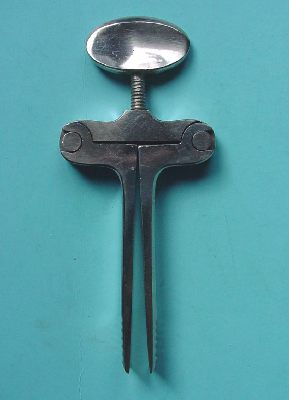Anesthesia |
||
Mouth opener (1) |
||
Before the time of muscle relaxation doctors used the "Munsdsperrer" developed by Lorentz HEISTER in the Barockzeit.
Lorenz HEISTER (1683-1758), who can be described in some respects as EISENBARTH's pupil, is considered one of the fathers of scientific surgery. Heister was present as a student in several operations of Eisenbartts and decided to first learn manual surgery, and then study medicine. Würzburg medicine of the 18th century was initially under the influence of the University of Leiden. Since the northern Netherlands was able to remain neutral in the Thirty Years' War, science was able to thrive here and influence the rest of the empire. The impetus for new developments came from the prince-bishops, who proved themselves to be progressive and generous supporters and wanted to realize the Leiden example in Würzburg as well. As early as the turn of the 17th and 18th centuries, Prince-Bishop Johann Philipp von Greiffenklau (1699-1719) set himself the goal of igniting the spirit of the Leiden School in Würzburg. He made numerous enhancements and improvements at Juliusspital to facilitate clinical education. Around 1720, Philipp Franz von Schönborn (1719-1724) transformed the garden pavilion of the Juliusspital, built by his predecessor in 1704, into an anatomical theater based on the example of Leiden and created the position of an anatomical prosector, who was also to be the Oberwundarzt of the Juliusspital. It was occupied in 1724 by Bishop Christoph Franz von Hutten (1724-1729) with Louis Sivert, a Parisian surgeon. With him began the series of practical surgeons at Juliusspital, who were initially in personal union as assistants of the professor of practical anatomy. Sivert's choice seemed to have been a stroke of luck, because he proved to be extremely skilled, but he left Würzburg the following year. The goal of bringing about an upsurge in surgery and anatomy was believed to have been achieved by Friedrich Karl von Schönborn (1729-1746) in 1731 by the appointment of the famous Lorenz Heister (1683-1758). Although the foundation letter allowed only Catholics in Würzburg doctorate and admission to the faculty, the Protestant received a generous offer, which even guaranteed free exercise of religion. However, Heister could not be taken away from his chair at the University of Helmstedt. Finally, in 1731, Georg Christoph STANG (1704-1779), who had received his education in Paris and Strasbourg, found a suitable senior surgeon for the Juliusspital, who for 48 years honestly did his duty as a surgeon, demonstrator of anatomy and midwifery teacher. This is how HEISTER became professor of anatomy and surgery in Altdorf. In 1720 he decided to write a German textbook for surgery, in which also the modern medicine for eyes and teeth and obstetrics should be included. HEISTER was a comprehensive mind of great interest to science. He owned a library of 12,000 volumes, had his own natural history cabinet and a collection of anatomical specimens. He also owned a collection of 470 surgical instruments, some made of silver. Heister has left many individual writings on medical and botanical issues.
|




